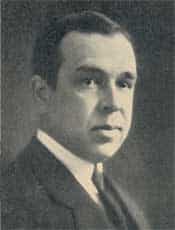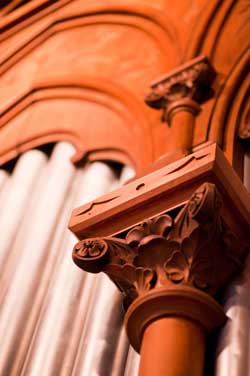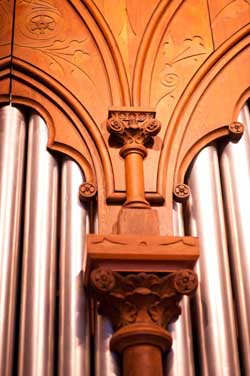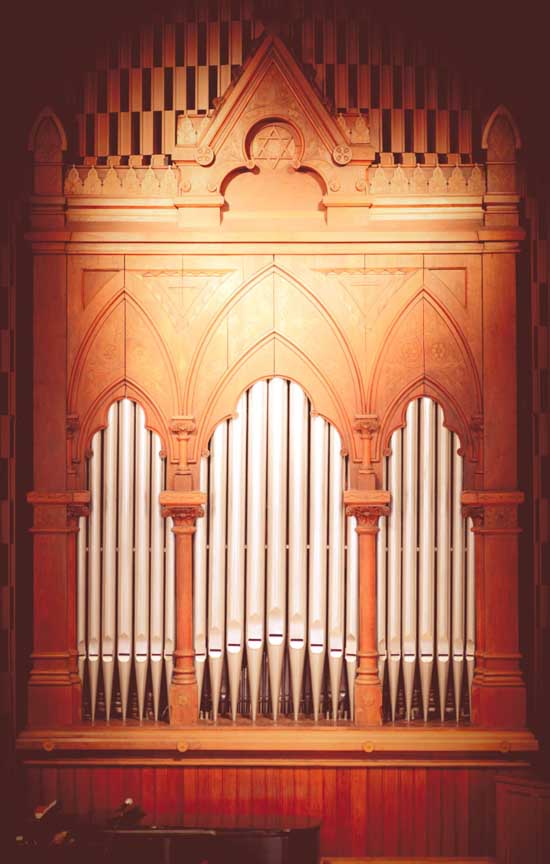 The following editorial by Dr. J. Gresham Machen appeared in the November 4, 1935 issue of The Presbyterian Guardian (vol. 1, no. 3). Machen’s editorials appeared under the title of “The Changing Scene and the Unchanging Word,” with Isaiah 40:8 as a referenced Scripture text. The Presbyterian Constitutional Covenant Union (PCCU) was organized by Machen and others on June 27, 1935 in part as a means of preparing for an eventual separation from the Presbyterian Church, U.S.A. For slightly less than two years, The Presbyterian Guardian was the official magazine of the PCCU, with its first issue appearing on October 7, 1935. Then, upon the formation of the Presbyterian Church of America (later the Orthodox Presbyterian Church), in June of 1936, the PCCU was dissolved and the magazine continued publication under the auspices of the Presbyterian Guardian Publishing Company. It was never an official publication of the OPC, though was always closely associated with that denomination, and publication continued until the October 1979 issue, when the magazine’s list of subscribers was turned over to The Presbyterian Journal.
The following editorial by Dr. J. Gresham Machen appeared in the November 4, 1935 issue of The Presbyterian Guardian (vol. 1, no. 3). Machen’s editorials appeared under the title of “The Changing Scene and the Unchanging Word,” with Isaiah 40:8 as a referenced Scripture text. The Presbyterian Constitutional Covenant Union (PCCU) was organized by Machen and others on June 27, 1935 in part as a means of preparing for an eventual separation from the Presbyterian Church, U.S.A. For slightly less than two years, The Presbyterian Guardian was the official magazine of the PCCU, with its first issue appearing on October 7, 1935. Then, upon the formation of the Presbyterian Church of America (later the Orthodox Presbyterian Church), in June of 1936, the PCCU was dissolved and the magazine continued publication under the auspices of the Presbyterian Guardian Publishing Company. It was never an official publication of the OPC, though was always closely associated with that denomination, and publication continued until the October 1979 issue, when the magazine’s list of subscribers was turned over to The Presbyterian Journal.
What Is “Orthodoxy”?
by the Rev. J. Gresham Machen, D.D., Litt.D.
[Note: Oddly, in what follows, Dr. Machen never stops to explain that “doxy” means “teaching”.]
Many years ago, in that ancient time when jokes now hoary with age had the blush of early youth upon their cheeks, when a man first asked, “When is a door not a door?” and when the answer seemed to be a marvelously fresh and brilliant thing—at some happy moment in that ancient time, some brilliant person said: “Orthodoxy means ‘my doxy’ and heterodoxy means ‘the other man’s doxy.’ “
The unknown author of that famous definition—unknown to me at least—may have thought that he was being very learned. Knowing that the Greek word “heteros,” which forms a part of the English word “heterodoxy,” means “other,” he built his famous definition around that one word, and “heterodoxy” became to him “the other man’s doxy.”
Possibly, however, he knew perfectly well that he was not being learned, and merely desired to have his little joke. As a matter of fact, the Greek word “heteros” in “heterodoxy” does not just mean “other” in the ordinary sense of that word, as when we speak of “one” man and “another” man, but it usually means “other” with an added idea of “different.”
So if we are really going to indulge in a little etymology, if we are really going to analyze the words and have recourse to the origin of them in the Greek language from which they have come, we shall arrive at a very different result from the result which was arrived at by the author of the facetious definition mentioned above. The word “orthos” in “orthodoxy” means “straight,” and the word “heteros” in “heterodoxy” means “other” with an implication of “different.” Accordingly, the real state of the case is that “orthodoxy” means “straight doxy” and “heterodoxy” means “something different from straight doxy”; or, in other words, it means “crooked doxy.”
Now I am not inclined to recommend etymology indiscriminately to preachers in their treatment of their texts. It has its uses, but it also has its abuses. Very often it leads those who indulge in it very far astray indeed. The meanings of words change in the course of centuries, and so the actual use of a word often differs widely from what one would suppose from an examination of the original uses of its component parts. Etymology has spoiled many a good sermon.
In this case, however, etymology does not lead us astray at all. Orthodoxy does mean “straight doxy,” and it is a good old word which I think we might well revive. What term shall we who stand for the Bible in the Presbyterian Church in the U.S.A. use to designate our position? For my part, I cannot say that I like the term “Fundamentalism.” I am not inclined, indeed, to quibble about these important matters. If an inquirer asks me whether I am a Fundamentalist or a Modernist, I do not say, “Neither.” Instead, I say: “Well, you are using terminology that I do not like, but if I may for the moment use your terminology, in order that you may get plainly what I mean, I just want to say, when you ask me whether I am a Fundamentalist or a Modernist, that I am a Fundamentalist from the word go!”
However, it is a different matter when we are choosing terminology that we shall actually use about ourselves. When we are doing that, I think we ought to be just as careful as we possibly can be.
The term Fundamentalism seems to represent the Christian religion as though it had suddenly become an “ism” and needed to be called by some strange new name. I cannot see why that should be done. The term seems to me to be particularly inadequate as applied to us conservative Presbyterians. We have a great heritage. We are standing in what we hold to be the great central current of the Church’s life—the great tradition that comes down through Augustine and Calvin to the Westminster Confession of Faith. That we hold to be the high straight road of truth as opposed to vagaries on one side or on the other. Why then should we be so prone to adopt some strange new term?
Well, then, if we do not altogether like the term “Fundamentalism”—close though our fellowship is with those who do like that term—what term shall we actually choose?
“Conservative” does seem to be rather too cold. It is apt to create the impression that we are holding desperately to something that is old just because it is old, and that we are not eager for new and glorious manifestations of the Spirit of God.
“Evangelical,” on the other hand, although it is a fine term, does not quite seem to designate clearly enough the position of those who hold specifically to the system of doctrine taught in the Westminster Confession of Faith, as distinguished from other systems which are near enough to the truth in order that they may be called “evangelical” but which yet fall short of being the system that is contained in God’s Word.
Therefore, in view of the objections that face the use of other terminology, I think we might do far worse than revive the good old word “orthodoxy” as a designation of our position.
“Orthodoxy” means, as we have seen, “straight doxy” [or “straight teaching, straight doctrine”]. Well, how do we tell whether a thing is straight or not? The answer is plain. By comparing it with a rule or plumb line. Our rule or plumb line is the Bible. A thing is “orthodox” if it is in accordance with the Bible. I think we might well revive the word. But whether we revive the word or not, we certainly ought to hold to the thing that is designated by the word.

 At the request of Dr. Robert G. Rayburn, then president of Covenant Theological Seminary, a search was launched for a good, used, tracker action pipe organ of suitable size to be located in the chapel which was about to begin construction. Leads were checked out; a two-manual (keyboard) organ at St. Henry’s Roman Catholic Church in Cincinnati, Ohio became the best prospect. The church’s congregation had dwindled, the organ had stood mute for years, and the Gothic building was slated for demolition. Negotiations for its purchase were quickly completed and generous members of the seminary board gave funds for its purchase, moving and rebuilding.
At the request of Dr. Robert G. Rayburn, then president of Covenant Theological Seminary, a search was launched for a good, used, tracker action pipe organ of suitable size to be located in the chapel which was about to begin construction. Leads were checked out; a two-manual (keyboard) organ at St. Henry’s Roman Catholic Church in Cincinnati, Ohio became the best prospect. The church’s congregation had dwindled, the organ had stood mute for years, and the Gothic building was slated for demolition. Negotiations for its purchase were quickly completed and generous members of the seminary board gave funds for its purchase, moving and rebuilding. The original builder of the organ, Johann H. Koehnken [1819-1901] emigrated from his native Saxony, where he had trained as a cabinetmaker and worked as one for two years, to continue his trade in Wheeling, West Virginia,, for another two years before arriving in Cincinnati in 1839. There he was taught organ building by his employer and fellow German Mathias Schwab, who had come to the United States in 1831. Schwab was the West’s first major organ builder, and he supplied finely wrought instruments over a wide area, including Detroit, Baltimore and St. Louis. Of the hundreds of organs built by Schwab, only two are know to exist in original condition and both are in Kentucky.
The original builder of the organ, Johann H. Koehnken [1819-1901] emigrated from his native Saxony, where he had trained as a cabinetmaker and worked as one for two years, to continue his trade in Wheeling, West Virginia,, for another two years before arriving in Cincinnati in 1839. There he was taught organ building by his employer and fellow German Mathias Schwab, who had come to the United States in 1831. Schwab was the West’s first major organ builder, and he supplied finely wrought instruments over a wide area, including Detroit, Baltimore and St. Louis. Of the hundreds of organs built by Schwab, only two are know to exist in original condition and both are in Kentucky.
